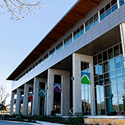Organizational Charges to the Chancellor 2023-2024
 |
|
Active Goals
Support student equity and success at Alamo Colleges District through a demonstrated awareness and willingness to address equity challenges and close performance gaps, including:
- Support student equity to achieve equitable educational outcomes for all students, with a focus on academically disadvantaged, economically disadvantaged, underserved students, underrepresented students, first-generation college students, and students twenty-five years of age and older.
- Align Alamo College’s Key Performance Indicators to reflect the new funding formula codified in House Bill 8 (2023 TX Legislative Session). Develop a system-wide portfolio to ensure these student success outcomes are achieved and requisite resources are reinvested in the organization.
- Implement action plans to close identified performance gaps among student groups and monitor their impact.
- Continue to enhance the Student Advocacy Network service portfolio to provide critical wrap-around support services for student retention and completion.
- Expand support services for parenting students, including possible expansion of childcare centers and drop-in services.
- Work to achieve the Texas Higher Education Coordinating Board and State of Texas’s strategic goals as outlined in the “Building a Talent Strong Texas” plan by increasing our yearly goal of 13,200 to 13,500 degrees & certificates achieved.
- Develop final proposal for a workforce-oriented bachelor’s degree program at Northeast Lakeview College to complement the portfolio of four previously approved bachelor degree programs. Begin developing framework of evaluative data from graduates to inform continuous improvement of the bachelor degree programs.
- Continue to increase course transfer alignment and transfer rates through the Regional University Transfer Compact and new partnerships with universities across Texas.
- Develop and implement hard-wired transfer partnership program utilizing AlamoINSTITUTES and the Transfer Advising Guides/Workforce Development Plans to ensure students from ACD transfer to four-year universities with at least 15 semester credit hours.
- Expand and create new and innovative workforce programs to meet the increased demand for talent in high-wage and high-demand occupations and industries.
- Expand Ready to Work and continue to support the city/county’s goals on student completion and job placement.
- Collaborate with city and county, greaterSATX/SA WORX, and chambers of commerce to enhance the region's workforce development efforts.
- Shorten students' time to certificate/degree completion and time to the labor market.
- Build and strengthen each College’s capacity to deliver premier, quality digital learning experiences for AlamoONLINE students further enhancing enrollment, retention, and completion.
- Develop a framework to support current capabilities such as recruitment, curriculum design, assessment, and career planning, while incorporating emerging capabilities for successful digital learning. Measure digital capabilities across the learner lifecycle, ultimately to support practical and sustainable approaches to digital services and online learning.
- Provide technology and internet service at no- to low-cost to facilitate connection to Alamo College District, with aligned staffing to support those needs.
- Align micro-credential strategy, adoption, implementation, and investment to Talent Strong Texas plan.
- Continue implementation of the overarching Alamo Colleges District-Wide Strategic Enrollment Management Plan to facilitate smart growth and increase market penetration into the community.
- Ensure a continued level of access through AlamoPROMISE with the recent Bexar County-wide expansion to seventy-three public high schools as well as charter, private, and home-schooled students. Continue to pursue collective impact strategies for increased funding.
- Expand and improve implementation of the various models and strategies including 4DX to achieve increased levels of persistence, graduates, and completers as set forth in our student success metrics and annual WIG.
- Develop new strategies to support student attainment of House Bill 8 (2023 TX Legislative Session) milestones.
- Identify areas of student/institutional challenges and set goals for improvement of student outcomes, including metrics that measure connection and completion success for Alamo College District learners.
- Scale high school equivalency offerings with a diploma option and dual credit opportunities across the Alamo Colleges District.
- Expand preparatory support for prospective ACD students pursuing the Texas Success Initiative Assessment (TSIA) college readiness exam.
- Build a competitive employee compensation program for faculty, staff, and administrators.
- Engage relevant groups in the development of a sustainable program aligned with the strategic priorities of the College District for recruitment and retention of high-quality talent.
- Increase educational attainment rates and improve economic and social mobility through a comprehensive portfolio of high school programs including Dual Credit, Early College High School, P-Tech, Alamo Academies, and other program models.
- Develop proposal to ensure 50% of dual credit students complete a sequence of at least 15 semester credit hours in dual credit courses by high school graduation.
- Successfully implement the downward expansion of the AlamoADVISE model to serve dually enrolled high school students.
- Utilize new Financial Aid for Swift Transfer (FAST) funding to expand AlamoBOOKS+ to all high school program partners.
Monitored Goals
Expand implementation and refinement of continuous improvement activities, including but not limited to the three elements of the AlamoWAY:
- Student Success
- Principle-Centered Leadership
- Performance Excellence
Strengthen the Alamo Colleges District brand, while promoting awareness of new and emerging Alamo Colleges District initiatives using targeted marketing and communications strategies such as:
- Increase synergy and collaboration in communications and marketing across the Alamo Colleges District by formalizing communications and marketing committees, councils and gatherings of subject matter experts across the Alamo Colleges District family.
- Enhance ties with prospective students and parents to encourage enrollment through community and neighborhood-based activations via Community Connections and other community outreach programs.
- Monitor and report on AlamoEXPERIENCE which will provide each graduating student with a workplace-based learning opportunity (i.e., apprenticeship, internship, community service/service learning, on-campus employment).
- Develop and implement the Earn & Learn component of AlamoEXPERIENCE allowing students to build professional social capital through apprenticeships, community service/service learning, internships, and employment opportunities.
- Increase collaboration and teamwork through top opportunities for improvement identified in the Great Place to Work survey results.
- Align the organization to reflect future economic demands.
More information:
| Office of the Chancellor | Board of Trustees |






